|
Printables |
PowerPoints |
Online exercises |
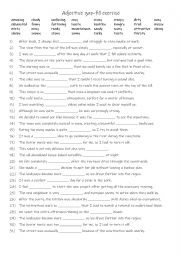
|
A2+-B1 Adjective gap-fill exercise
Students familiarise themselves with the 31 adjectives and their meanings. Then they read the sentences to see which adjective is required to complete the gap-fill.Answers on page 2.
Level: intermediate
Age: 9-100
Type:
Downloads: 104
|
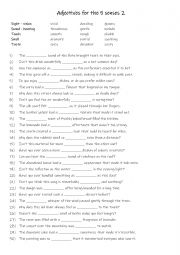
|
A2+-B1 Adjectives for the 5 senses 2
Students should learn adjectives for the five senses (sight, sound, touch, smell, and taste) because they enhance descriptive language and make communication more vivid and engaging. Using specific adjectives like vivid or gloomy for sight, melodic or thunderous for sound, and smooth or rough for touch allows students to convey precise impressions ...
Level: intermediate
Age: 9-100
Type: worksheet
Downloads: 118
|
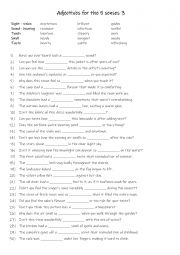
|
A2+-B1 Adjectives for the 5 senses 3
Mastering these adjectives helps students describe experiences, express emotions, and write creatively, fostering richer and more impactful communication. First, students need to familiarise themselves with 15 adjectives and check their meaning and use. Then they read the sentences to see which one is needed to complete the sentence. Answers on pag...
Level: intermediate
Age: 8-100
Type:
Downloads: 107
|
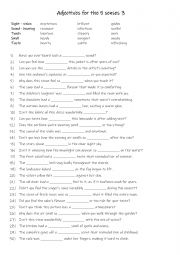
|
A2+-B1 Adjectives for the 5 senses 3
Mastering such language fosters creativity, improves storytelling, and builds confidence in expressing sensory experiences. Ultimately, this enriches their ability to communicate thoughts, emotions, and observations effectively in both academic and real-world settings. First, students need to familiarise themselves with 15 adjectives and check thei...
Level: elementary
Age: 9-100
Type:
Downloads: 105
|
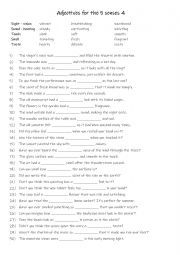
|
A2+-B1 Adjectives for the 5 senses 4
Mastering these adjectives helps students describe experiences, express emotions, and write creatively, fostering richer and more impactful communication. First, students need to familiarise themselves with 15 adjectives and check their meaning and use. Then they read the sentences to see which one is needed to complete the sentence. Answers on pag...
Level: intermediate
Age: 10-100
Type:
Downloads: 112
|
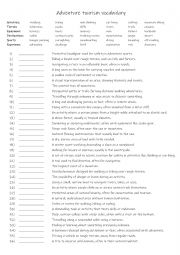
|
A2+-B1 Adventure tourism vocabulary
First, students need to familiarise themselves with the 25 words and their meanings Then they read the definitions to see which one is being described and write that word in the space provided. Answers on page 2.
Level: intermediate
Age: 10-100
Type:
Downloads: 125
|
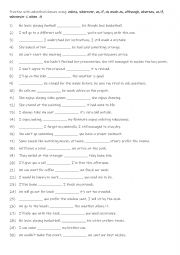
|
A2+-B1 Adverbial clauses 4
Learning adverbial clauses using words like unless, wherever, as, if, as much as, although, whereas, as if, whenever and when helps students express complex relationships between ideas, such as condition, time, contrast, and manner. First, students need to familiarise themselves with the 10 adverbial clauses and their use. Then they read the senten...
Level: intermediate
Age: 10-100
Type:
Downloads: 118
|
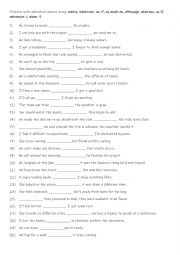
|
A2+-B1 Adverbial clauses 5
Learning adverbial clauses using words like unless, wherever, as, if, as much as, although, whereas, as if, whenever and when helps students express complex relationships between ideas, such as condition, time, contrast, and manner. First, students need to familiarise themselves with the 10 adverbial clauses and their use. Then they read the senten...
Level: elementary
Age: 9-100
Type:
Downloads: 109
|
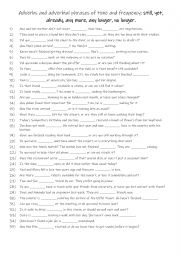
|
A2+-B1 Adverbs and adverbial phrases of time and frequency still, yet, already, any more, any longer, no longer.
These adverbs help students specify when actions or events occur. For example, "still" and "yet" are useful for indicating whether an action is ongoing or expected, while "already" specifies that something has happened before now.These adverbs are often used in various social and professional contexts to discuss schedules, deadlines, and changes, m...
Level: intermediate
Age: 10-100
Type:
Downloads: 102
|
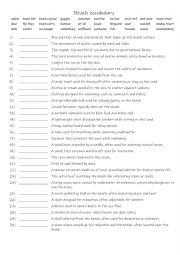
|
A2+-B1 Beach vocabulary - 30 words
Students familiarise themselves with the 30 beach related words and their meanings. Then they read the definitions and write the word being described in the space provided. Answers on page 2.
Level: elementary
Age: 8-100
Type:
Downloads: 120
|
|
|
|
|












